Insect & Disease Conditions Update
A printer-friendly version of this report is available on-line from the Conditions Report Index.
National Emerald Ash Borer
Awareness Week is always celebrated the week prior to Memorial Day weekend—the
big kickoff to camping (and firewood travel) season across the nation. It is set at this time to remind people that
moving firewood long distances is no longer an acceptable practice. In many cases, it is illegal. Even though people are often aware of the
reasons behind not moving firewood, many believe that their firewood is safe,
so not part of the problem (Snell et al.,
2014*). Emerald ash borer is a great
example, but only one of many, of why you should “buy it where you burn it.” We
know that in Michigan, about 75% of outlying infestations of emerald ash borer
were started because of the movement of infested firewood. Others among the many in the ranks of forest
pests that can move readily on firewood include oak wilt, brown spruce
longhorned beetle, Asian longhorned beetle, winter moth and gypsy moth. During this National Emerald Ash Borer
Awareness Week we ask that you join us in the effort to educate others about
the reasons why leaving your firewood
at home is so important. We invite you to visit our firewood page for
more information.
*From: Campers and Invasive Forest Pests in
Northern New England
In this issue:
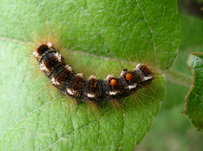 Browntail
Moth (Euproctis chrysorrhoea) –
Beware!
Browntail moth caterpillars
are feeding voraciously in coastal Maine and inland. The infestation is
centered in the Bath/Brunswick (Sagadahoc/Cumberland Counties) but infested
trees can be found from Kittery (York County) to Warren (Knox County) and
inland to Turner (Androscoggin County) and Waterville (Kennebec County). The
caterpillars are already stripping the trees of leaves in heavily infested
areas and crawling across lawns, houses and cars to get to more food.
Photo: Browntail Moth (Euproctis chrysorrhoea) Note two orange
spots on rear end. (Maine Forest Service)
The hairs from this caterpillar can cause a
rash or respiratory distress in sensitive individuals. The hairs break off from
the skins shed by the caterpillars. The hairs then blow in the wind or are
stirred up by mowing, weedwacking, raking etc. Use caution when working
outdoors in infested areas.
|
 Canadian Pine Scale (Matsucoccus
macrocicatrices) – Samples of eastern white pine collected in T4 R11 WELS
and T5 R11 WELS (Piscataquis County) for examination of pine leaf adelgid
damage (see entry below) were found to also have what appear to be the
overwintering cysts of Canadian pine scale.
Scales were found most commonly at branch nodes, but were also found on
internodes. One emerged adult was found
on the samples. This insect is generally
thought to be of little significance from a tree-health perspective; although
work is currently being done to understand more about its role in white pine
dieback in southern states (for a recent MS thesis on the topic see: https://getd.libs.uga.edu/pdfs/schulz_ashley_n_201508_ms.pdf).
Photo: Overwintering
cyst (left) and emerged adult (right) believed to be species Matsucoccus macrocicatrices on eastern
white pine. (Maine Forest Service)
|
 Eastern Tent Caterpillar (Malacosoma
americana) – The webs of eastern tent caterpillar are quite abundant this
year, with many cherries and apples supporting numerous webs. These webs usually originate in branch
junctions. They’ll be full of the frass
of well-fed caterpillars and often the caterpillars themselves. If the webs are
an aesthetic problem, the best way to manage them is to wind them around a
forked stick in the cool hours of the morning or evening, thereby ensnaring the
occupants. You can relocate the webs to
another host tree out of sight (they do feed generalist predators and other
beneficial insects), soak them in a bucket of soapy water or dispose of them in
a sealed plastic bag. Be cautious in
browntail territory not to confuse the webs of the two species and also because
you will sometimes find browntail moth caterpillars snuggled in with their
cousins in the safe haven of the eastern tent webs.
Photo: Eastern tent caterpillar
webs are often found in cherry and apple trees.
(Maine Forest Service)
|
Emerald Ash Borer (Agrilus planipennis) – All trap trees girdled in the spring of 2015 were negative for signs of emerald ash borer (EAB). We are starting to girdle trees again this year to continue monitoring for EAB. If you have an ash tree of any species over four inches diameter at 4.5 feet that you would be willing to sacrifice as a trap tree, please email Patti Roberts at patti.roberts@maine.gov with the subject line Trap Tree and we will help you create a trap tree.
 This time of year the native six-spotted tiger beetle
adult has made its first appearance across the state. These blocky,
long-legged, metallic green beetles are often mistaken for EAB. Adult EAB have
not emerged yet in this region. EAB adults emerge at 550 GDD or when the
black locust bloom. The Northeast
Regional Climate Center includes Concord, NH on their webpage Growing Degree
Day Accumulations to support the tracking of emerald ash borer emergence.
Photo: The native, beneficial six-spotted tiger beetle, Cicindela sexguttata. (Wikimedia commons)
|
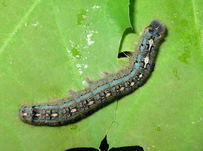 Forest Tent
Caterpillar
(Malacosoma disstria) – Although a close relative of the eastern tent caterpillar the forest
tent caterpillar does not make tents. It feeds on the buds and leaves of oak,
poplar, maple, birch and other hardwoods in the spring. The number of moths in
light traps were up from the usual level from South Berwick (York County) and
Hope (Knox County) to Crystal (Aroostook County) and Topsfield (Washington
County). Maine has not had an outbreak of forest tent in decades so this is one
to watch. Caterpillars feed on the leaves and then mass together on the trunks
of trees when they mature and are starting to look for places to pupate.
Photo: Forest Tent Caterpillar, Malacosoma disstria, on a maple
leaf (Maine Forest Service)
|
Ground-Nesting
Bees – Beginning in very early
spring, solitary ground-dwelling bees emerge and become active. When they first
emerge they are usually very active, with much flying around, mating,
exploration and nest-building. As people increase their yard-work activities,
they begin to notice the bees. All the activity by bees can look frightening.
However solitary bees (one nest for each female, although you may have many
nests in one area) are generally non-aggressive and must be severely harassed
before they sting. The males often look aggressive while they fly around
searching for a mate, but they can’t sting at all. This heightened activity
persists for only a week or two, and then the bees are almost unnoticeable.
Ground nesting bees are valuable pollinators.
Gypsy
Moth (Lymantria dispar) – Eggs are hatched or
hatching for this pest in southern Maine.
Gypsy moth egg hatch was noted in Old Town (Penobscot County) on May 12th,
egg hatch will progress north with the warming season. After hatching the
larvae crawl towards the tops of host plants.
Many will put out a line of silk and be carried on air currents to new
locations. Gypsy moth is a pest to watch
for in Maine—its populations occasionally outbreak and significant defoliation
can occur. The last gypsy moth epidemic
in Maine ended in 2002, with more than 51,000 acres defoliated that year. This pest first arrived in Maine around the
turn of the last century, and it has not yet become established in the far
northern Maine. A map of the area
currently known to have reproducing populations of Gypsy Moth is available on-line.
Hemlock
Woolly Adelgid (Adelges tsugae) – Hemlock woolly adelgid (HWA) eggs were
abundant in Camden (Knox County) last week.
Crawlers will have already emerged in warmer areas of the state. Eggs and/or crawlers are more or less
continuously present until late-July or early August. These life-stages can be spread on items other
than the host trees (clothing, equipment, pets, etc.).
HWA is a quarantined pest. All products may move freely within the
quarantined area. Roundwood products
such as logs and pulp may be moved freely within Maine, but must be free from
branches. Material with branches, such
as chips, moved outside the quarantine area must go to facilities with
agreements to receive the material.
Quarantine regulations are slightly different in neighboring New
Hampshire and Vermont.
 Pine Leaf Adelgid (Adelges pinifoliae) – Pine leaf adelgid damage visible during
aerial survey was mapped on over 262, 000 acres in Piscataquis County last
year. Less severe damage extended beyond
the area mapped. 2015 shoot growth was
scant and significantly reduced compared to 2014 growth on samples collected in
the Telos area this week. 2014 growth seemed to be most heavily colonized by
the nymphs, which would indicate we should expect cone-like galls on
current-year spruce growth (red and black) this year. This is counter to what is in the literature,
which reports galls in odd numbered years, so will be interesting to monitor. Maine Forest Service Forest Inventory crews
will help monitor the progression of this pest in the North Maine Woods this
year during the course of their regular work in the area. Others working in the affected area are
encouraged to send reports of damage either to spruce or pine. Bear in mind, samples may be needed to
identify the causal agent.
Photo: Abnormally
swollen shoots on spruce caused by pine leaf adelgid would be visible as the
buds expand. When the galls mature they
resemble pine cones. Unlike some other
adelgid galls on spruce, these are not persistent on the branches, and most
drop within the year they are formed. (W. Cranshaw, CSU, bugwood.org)
|
Winter
Moth (Operophtera brumata) – Winter moth are
feeding on leaves of oaks, apple, birch, blueberries, and other trees and
shrubs. They are still tiny but expect to see increased defoliation over the
next two weeks. The little green inch worms will then string down on silk to
spin cocoons in the soil below the trees. There they will stay until December
when the moths emerge to mate and lay eggs. DO NOT MOVE soil, perennials,
saplings etc. from under or near winter moth infested trees. You will be moving
winter moth with the soil/plant material. The cocoons look like dirt. Nurseries
that sell perennials often keep the potted plants under trees to shade them
from the sun. These pots need to be protected from infestation by winter moth
larvae dropping into them over the next 2-3 weeks. Winter moth is currently
found along the coast from Kittery (York County) to Mount Desert Island
(Hancock County).
If you see Swiss cheese-like defoliation (or
worse) in other parts of Maine, please contact us. We are looking for Bruce
spanworm infestations in particular but would be interested in other
significant areas of defoliation as well.
Dothistroma Needle Blight (Dothistroma septosporum) – David Lambert with Cooperative Extension
identified Dothistroma needle blight
on Austrian Pine from samples collected in Turner (Androscoggin County). Moisture control alone or in combination with
fungicide applications to current-year foliage can help manage this disease in
ornamental settings. More information is
available on-line.
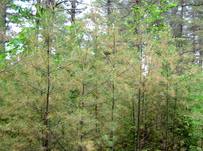 White Pine Needle
Diseases – One-year-old
needles of white pines infected with any one of the several needle diseases
prevalent during the past several years will begin to appear yellowish-brown to
tan and start to be shed from affected trees within the next two weeks or so.
The great majority of infections are caused by the brown spot fungus, Lecanosticta acicola (= Mycosphaerella dearnessii), but several
other fungal pathogens may also be present. Needle shedding is expected to be heaviest
throughout the month of June, and should be largely completed by the first week
in July. Affected trees will appear thin
in the crowns, as the current-season needles will not yet be fully expanded.
In white pine stands that
have a known history of several consecutive years of needle loss, manage
carefully, and avoid thinning or other disturbance-related activities that
could further weaken trees.
Current-season needles of ornamental white pines may be protected from
infection with a foliar fungicide application of copper or chlorothalonil. Applications should be made shortly after
budbreak and again two weeks later, to protect the fully-elongated needles.
White pine needle
disease infection levels appear to be highly regulated by wet weather; long
periods of damp weather and high rainfall increase the probability of
infection. Although much of the growing
season in 2015 was drier than in recent past, the month of June was wetter than
normal. 2015 infection levels may remain
similar to what has been seen in recent years or slightly abated.
Photo: Young white pine regeneration heavily infected with brown spot needle disease,
Bethel, Maine on June 14, 2011. (Maine Forest Service)
|
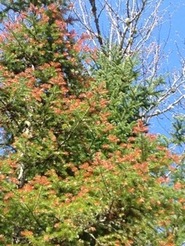 Winter Drying Injury – Damage attributed
to winter drying injury was reported in Old Town (Penobscot County). The landowner reported scattered balsam fir
with reddened 2015 growth. Weather conditions
were consistent with those reported to predispose trees to this type of damage,
specifically winter thaws cause tissues to lose hardiness and become vulnerable
to injury from subsequent freezing temperatures.
Photo: Damaged
balsam fir tips, Old Town, ME (Photo: L. Beauregard).
|
Spruce
Budworm Forum. Wednesday, May 25th,
Mallett Hall, Lee ME, 5-7pm. Join Lee Academy Teacher Susan Linscott and
her students for a forum on spruce budworm. Speakers will include Allison
Kanoti, Forest Entomologist and Terri Coolong, District Forester, both from
Maine Forest Service and Wildlife Biologist Barry Burgason from Huber Resources Corporation.
Conditions Report No. 2, 2016
On-line: http://maine.gov/dacf/mfs/publications/condition_reports.html
Department
of Agriculture Conservation & Forestry
Maine
Forest Service - Forest Health and Monitoring
Contributors: Charlene
Donahue, Allison Kanoti, Colleen Teerling
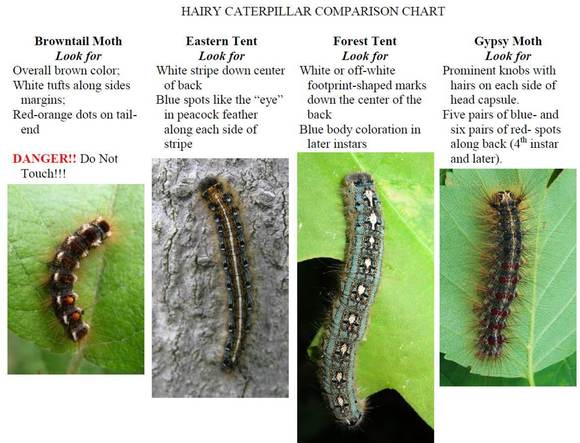 For more information:
|